|
| Himalayan Wonder-Flower |
|

|

| File size | 269515 |
| Original date | 9/6/20 8:01 PM |
| Resolution | x |
| Flash | Flash did not fire, auto |
| Focal length | 55.0mm |
| Exposure time | 1/250s |
| Aperture | 8.0 |
| Focus Distance | |
| Metering Mode | $meteringMode |
| Camera make | NIKON CORPORATION |
| Camera model | NIKON D5300 |
| Sensor type |
|
|
|
|
Photo: |
Botanical name: Mirabilis himalaica Family: Nyctaginaceae (Bougainvillea family)
Synonyms: Allionia himalaica, Oxybaphus himalaicus
Synonyms: Allionia himalaica, Oxybaphus himalaicus
Himalayan Wonder-Flower is an interesting plant which
is the Himalayan cousin of the popular garden flower
Four O'clock. The genus name Mirabilis
means 'wonderful', and also the common name Wonder-Flower. It is a more or less
creeping herb with pale reddish-brown stems, almost heart-shaped leaves
and small, light rose to dark pink flowers. The oppositely arranged
ovate leaves are up to 6 cm long, with stalks up to 2 cm long. The
leaves in the upper part are covered with short, soft hairs, especially
on the underside, in the lower part they are hairless or sparsely
covered with long, prostrate hairs. Flowers are arranged in lax, leafy,
sticky panicles. Flowers are bell-shaped to funnel-shaped,
approximately 5-6 mm across. The base of the flower is surrounded by an
involucre of five bracts which resembles a sepal-cup. The involucre is
covered with stalked purple-tipped glands. Fruit is a compressed, ovoid
achene, which is surrounded by the persistent base of the involucre and
contains one seed. The plant has a long, swollen root, which serves as
a storage organ and enables the plant to get through the dry and cold
seasons. Himalayan Wonder-Flower is native to Himalaya to NW India and
Central China, at altitudes of 2300-4000 m. Flowering: July-September.
Medicinal uses: Himalayan Wonder-Flower is
used in traditional Tibetan folk medicine. It has been historically
employed in nourishing the kidney, regenerating tissue, for diuresis,
and in removing kidney stones, with accounts that could be traced back
to more than 1300 years ago.
Himalayan Wonder-Flower is
used in traditional Tibetan folk medicine. It has been historically
employed in nourishing the kidney, regenerating tissue, for diuresis,
and in removing kidney stones, with accounts that could be traced back
to more than 1300 years ago.
Medicinal uses:
 Himalayan Wonder-Flower is
used in traditional Tibetan folk medicine. It has been historically
employed in nourishing the kidney, regenerating tissue, for diuresis,
and in removing kidney stones, with accounts that could be traced back
to more than 1300 years ago.
Himalayan Wonder-Flower is
used in traditional Tibetan folk medicine. It has been historically
employed in nourishing the kidney, regenerating tissue, for diuresis,
and in removing kidney stones, with accounts that could be traced back
to more than 1300 years ago. | Identification credit: Ashutosh Sharma, Nidhan Singh | Photographed at Kalpa, Kinnaur, Himachal Pradesh. |
• Is this flower misidentified? If yes,